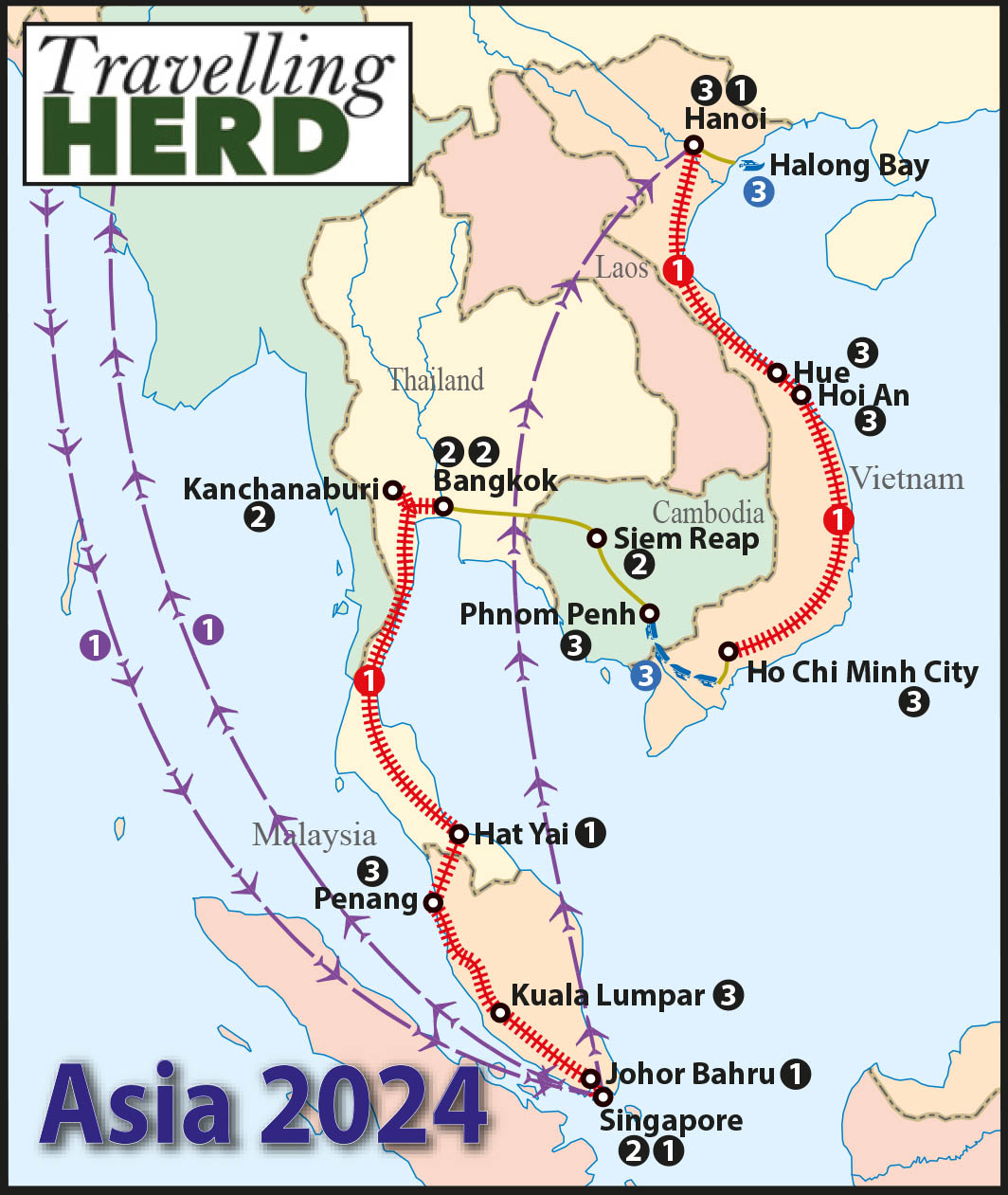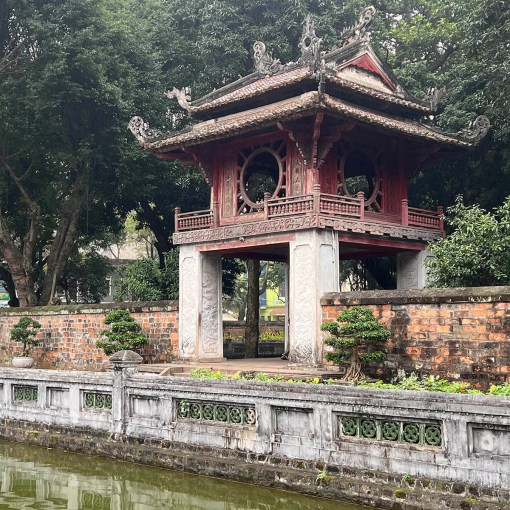Read this blog: The one where we cruise around the famous UNESCO site
Sunday 10th and Monday 11th March 2024
We like to travel light and for this trip we planned to each have three packs of four days’ worth of clothing and then rely on the laundry service at the various hotels we stayed in. We also carry one of each other’s packs so that should one suitcase go astray at any point, we will both still have a change of clothes.
We were told that we needed to allow eight hours for our clothes to be returned so dropped our laundry off as we were heading out to the Citadel the day before we would be leaving for Hạ Long. We were presented with a very neatly packaged set of clean clothing which we left intact for ease of packing.
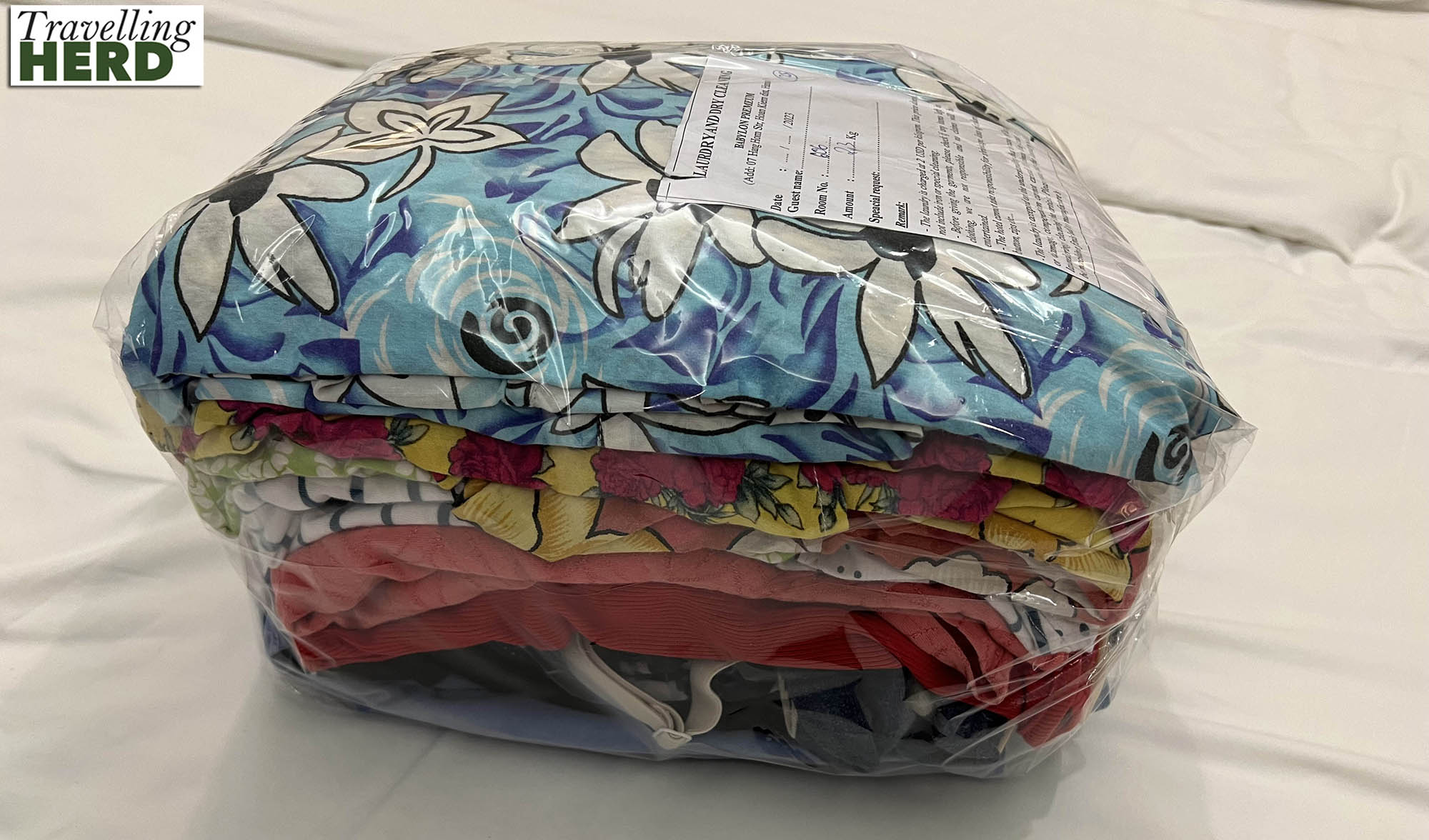
Robert had pre-booked a cruise in Hạ Long Bay with Phoenix Cruises as this company also provided coach transport to and from the dock. Having looked at the timings, Robert realised that on a one night tour, we would barely have a full day in Hạ Long Bay and so opted for the two night cruise.
The port at Hạ Long is far more busy and commercialised than we had expected. It is lined with landing stages and many company’s have their own dedicated building and quay. The wider area is dominated by unfinished buildings, which we were told had been started before planning permission was granted and subsequently had to be abandoned. Consequently it is a strange mixture of ghost town and hive of industry.
Small tenders transport passengers from the quayside at Hạ Long to the cruise ships.

Every time passengers get on a tender they have to put on a life jacket although we found that not all of them have fastenings which secure properly so they might not have been much use in an emergency.
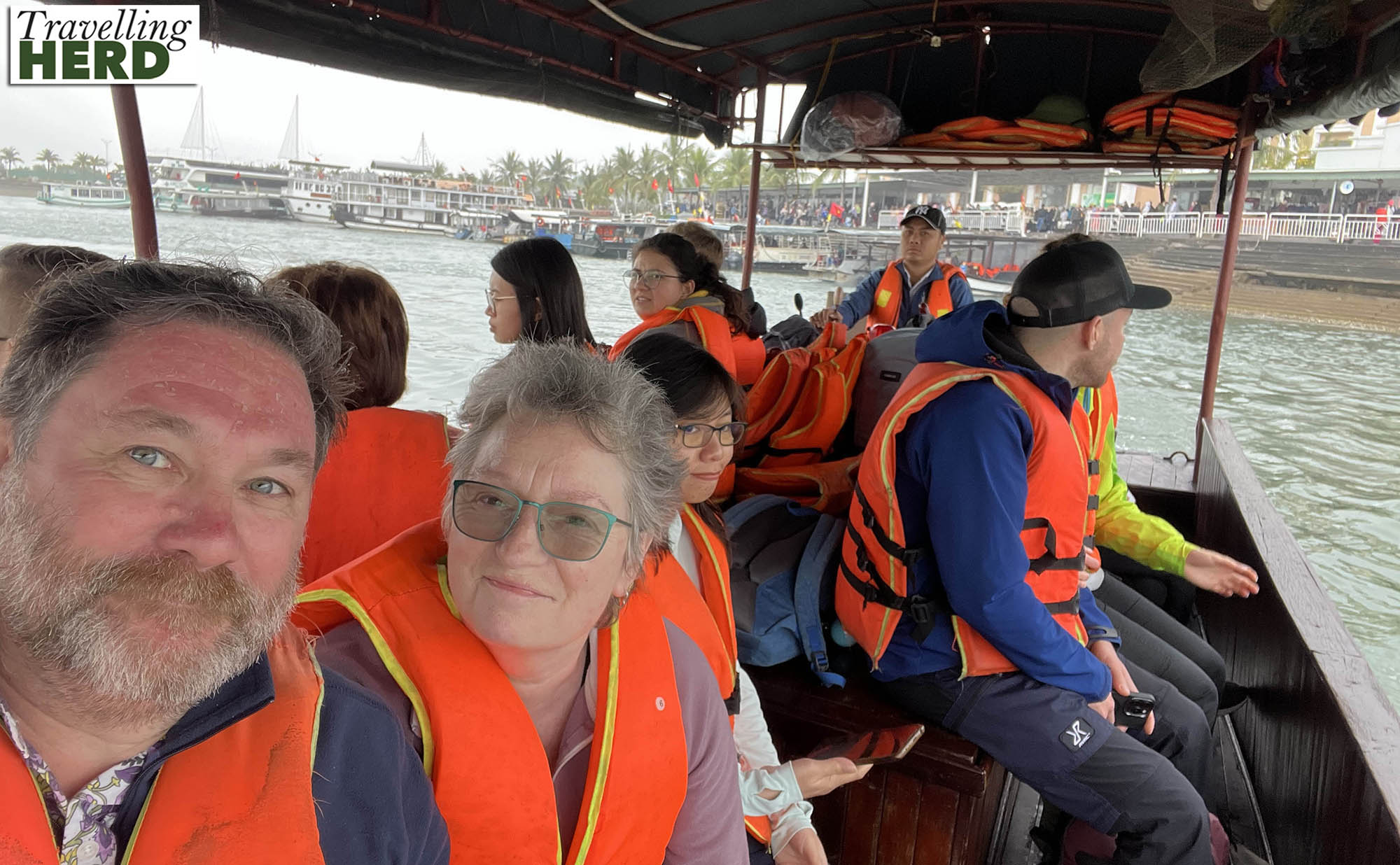
Our en suite room on the Hạ Long Phoenix Cruiser was compact with very little storage space but it was nevertheless pleasant, clean and comfortable.
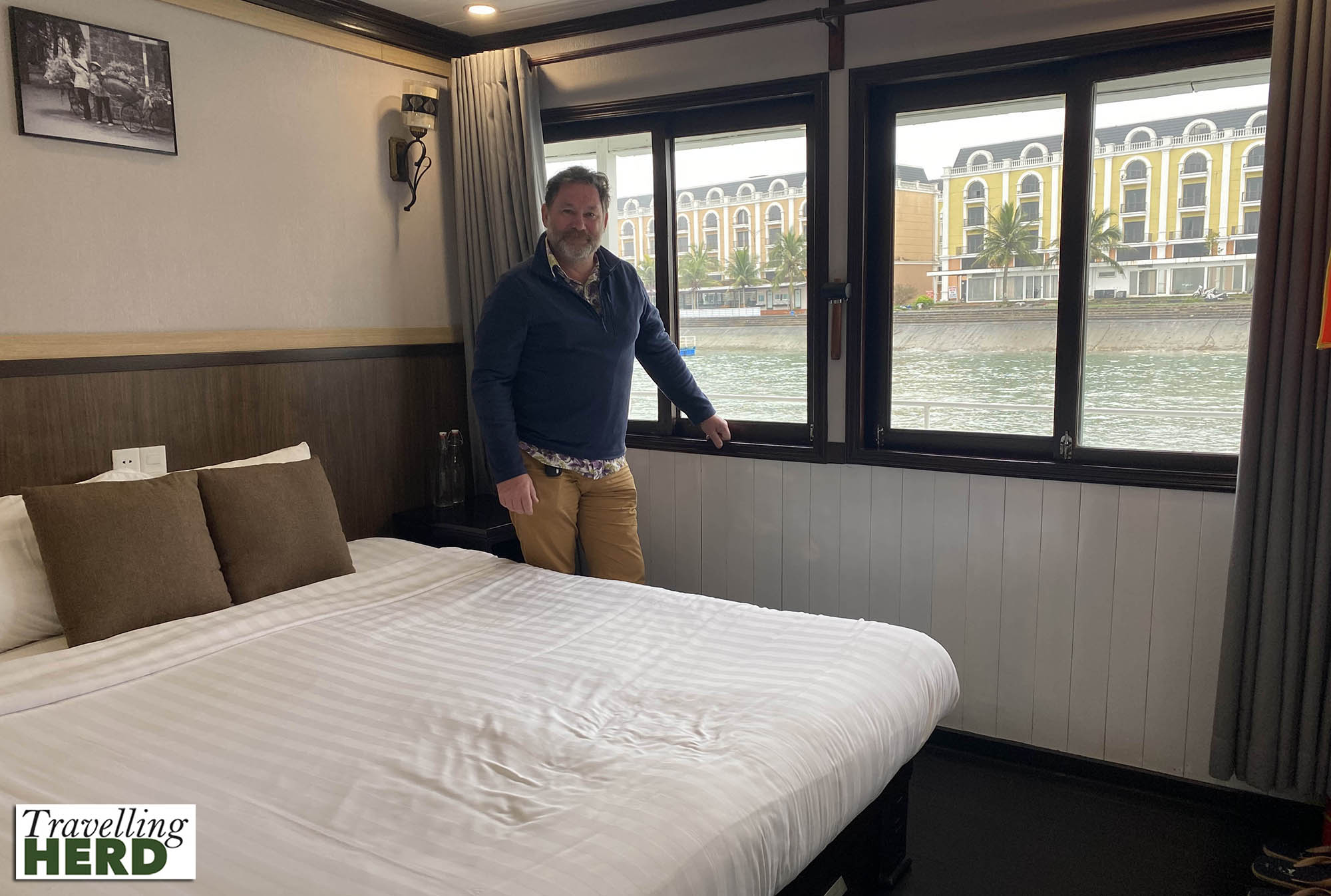
Hạ Long Bay spans around 1,553 km2 or 600 square miles, and includes nearly 2,000 [1,969] islets, called karsts, formed by tectonic movements over the course of half a billion years. Even in overcast cloudy weather it is indeed beautiful.
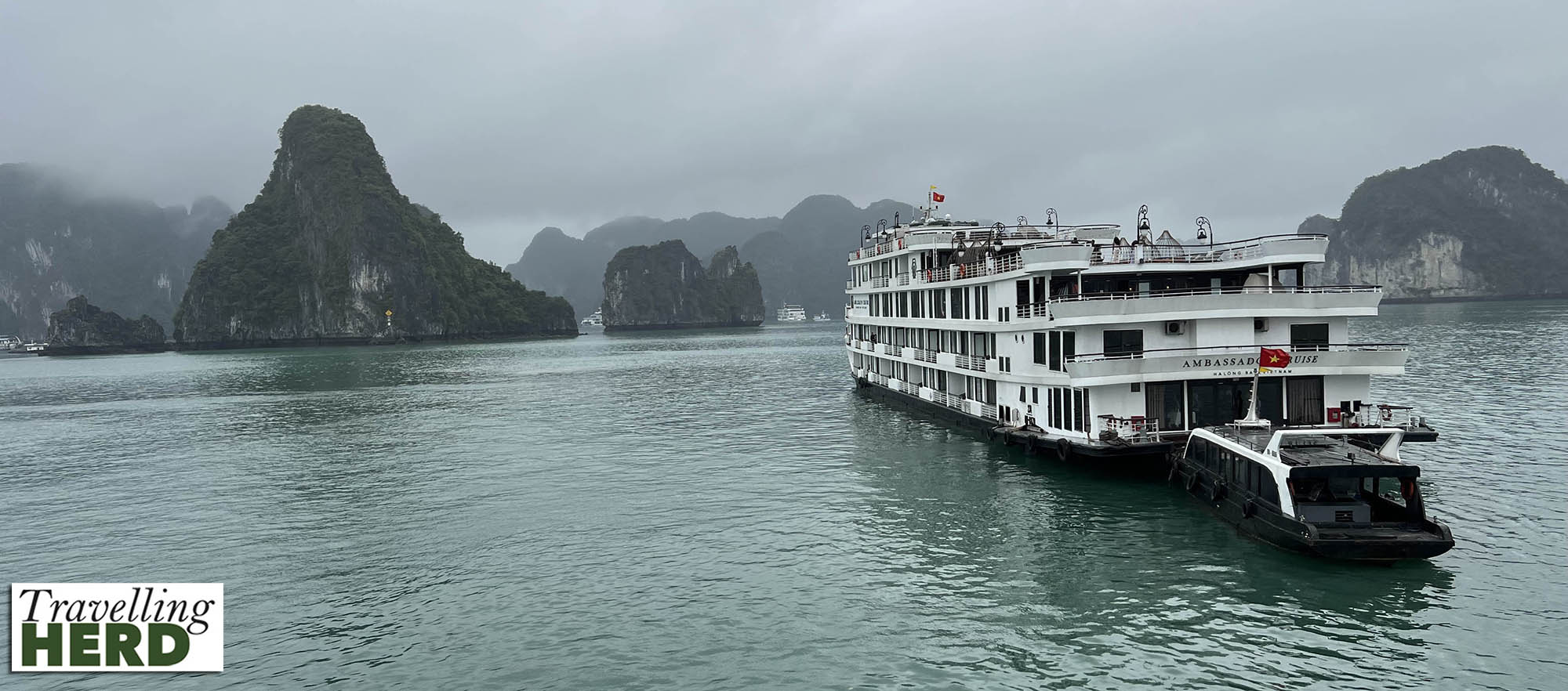
The majority of tourists visit the central part of this area where 775 islands, or karsts, mostly made of limestone are concentrated in 129 square miles [334 km2].
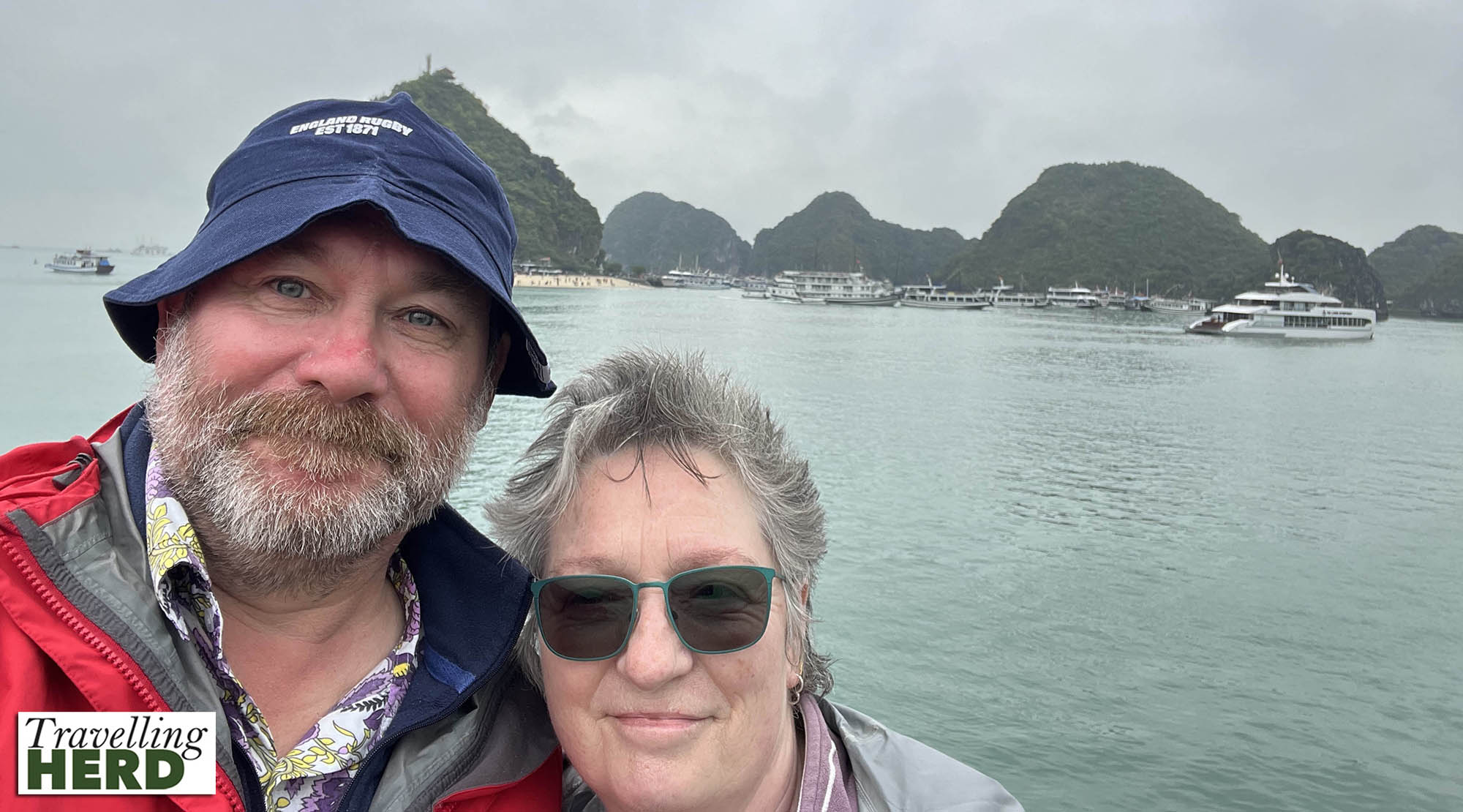
Although the day was characterised by low-lying mist our first excursion was to Ti-Top Island, roughly 6 miles or 10 km from mainland Hạ Long, which, despite being one of the smallest islands, is one of the region’s most recognisable landmarks and boasts an observation point which is said to offer fine views of the area.
The name Hạ Long is relatively recent [late 19th century] and means “descending dragon”. According to legend, the islands were created when a family of dragons was sent to help protect the Vietnamese people by spitting out jewels and jade which linked together to form a defence against their aggressors. Other islands are said to have risen out of the sea to protect the country and after the battle it is said the dragons chose to stay and live in the area.
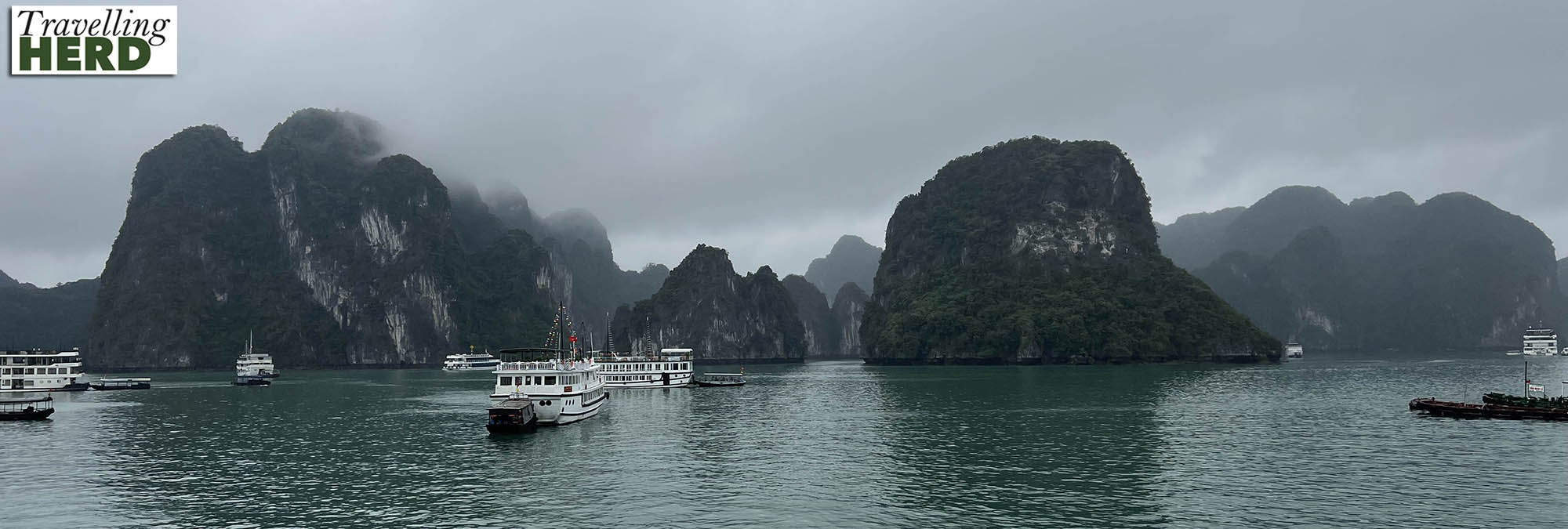
As we approached Ti-Top Island there were fully clad Vietnamese visitors walking on the sandy beach and it was noticeable that the only people actually venturing into the water to swim were westerners. Matilda herself felt she could have been very tempted in warmer weather.
Once disembarked, we walked towards the steps leading up to the summit. As did all the other tourists.
Given the low cloud which would have obscured the view and the queue of people waiting to ascend we decided we would not go up.

Instead we walked along the front as far as we could and watched the people on the beach.
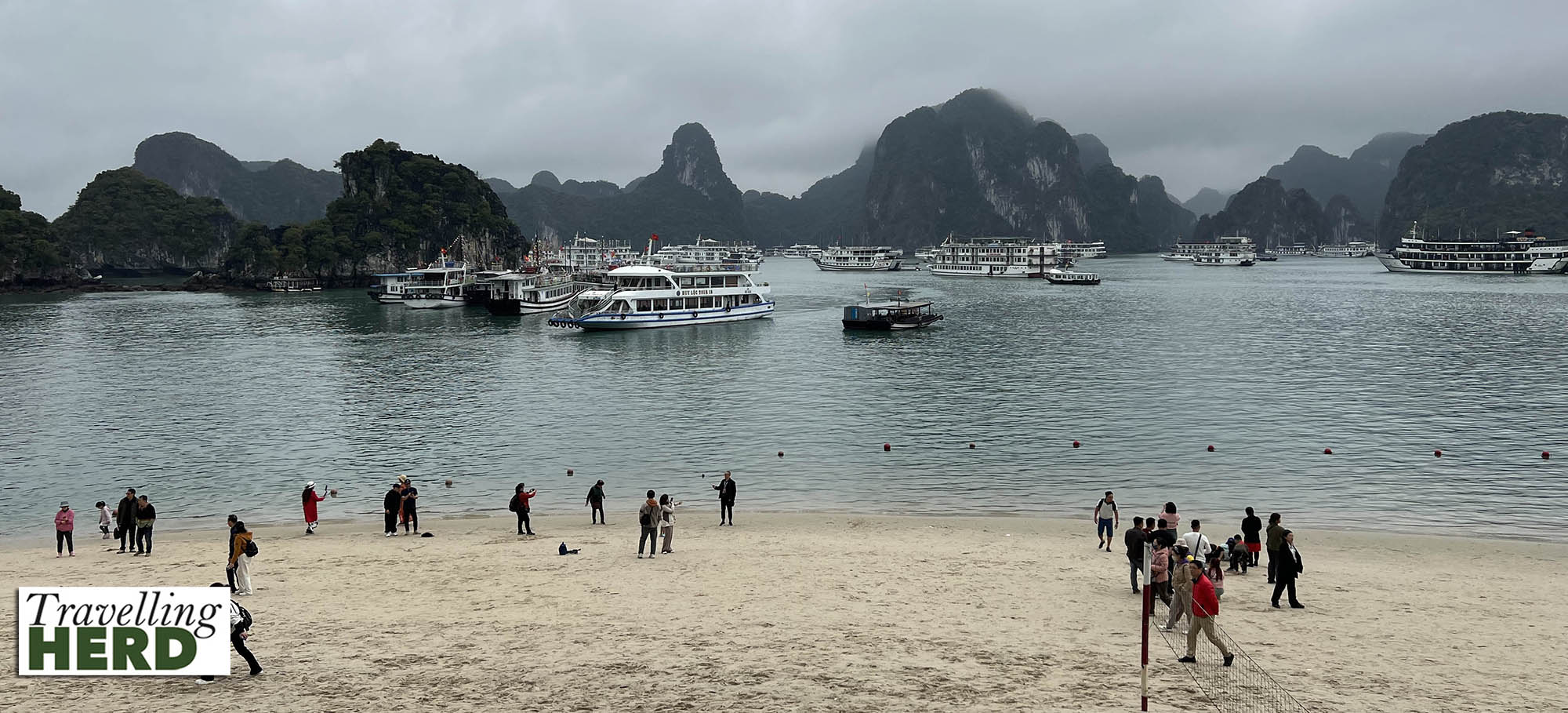
Originally called simply Island No. 48, its name was changed in 1962 after the Soviet cosmonaut, Gherman Titov, toured Hạ Long Bay with the then-President Ho Chi Minh and admired the sheer beauty of the place.
The previous year Titov had become the second human to orbit Earth (four months after Yuri Gagarin) and Ho Chi Minh decided to cement their friendship, and the link between their countries, by naming the island Ti-Top which is the Vietnamese pronunciation of his name.
Titov visited again in 1997 and after he died in 2000, the People’s Committee of Quang Ninh Province decided to erect a statue of him posthumously at the landing point to welcome all visitors.
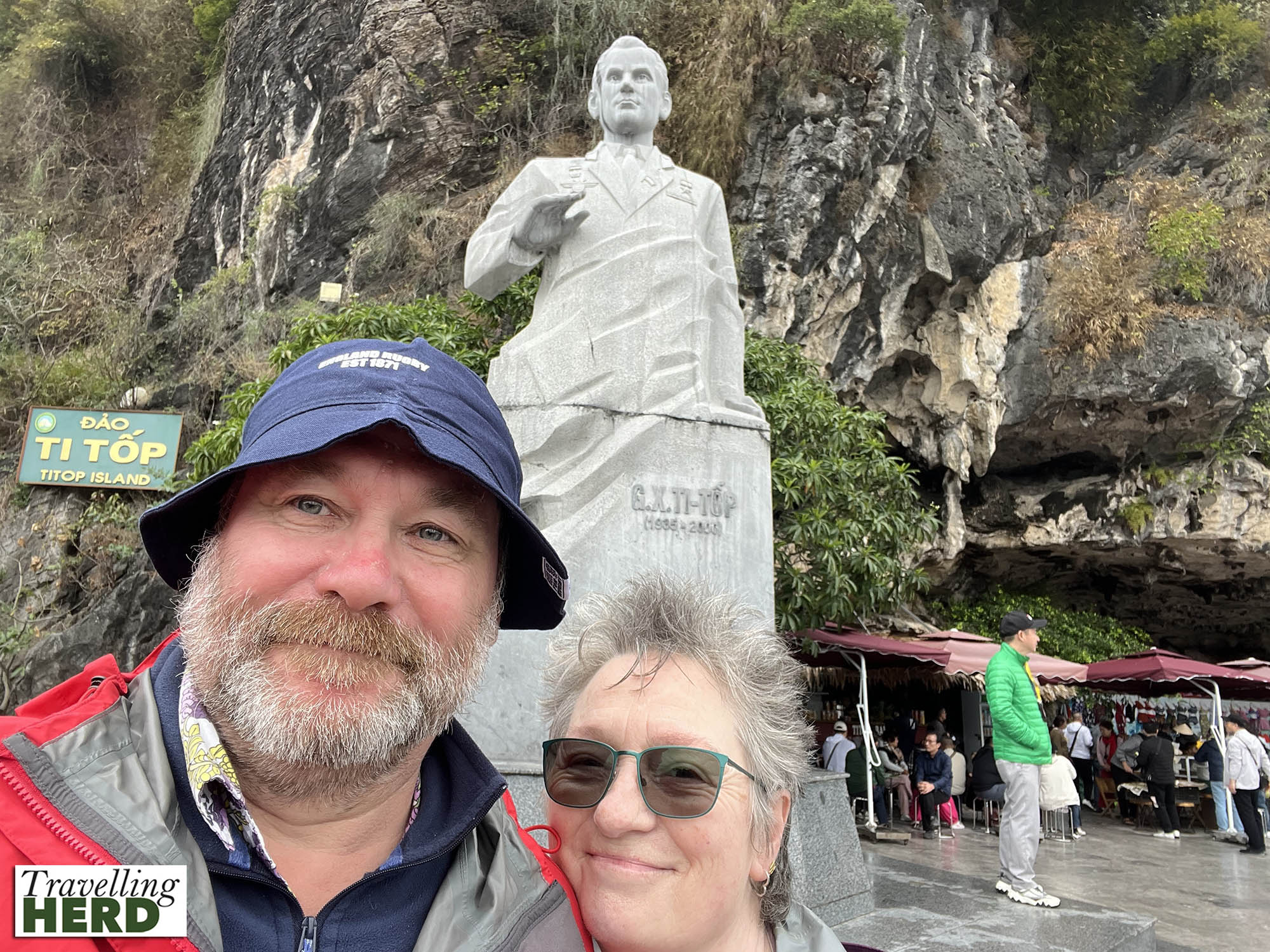
For those not local to the area it is difficult to navigate and tell one island from another and judging by the names given to the islands, the Vietnamese had similar problems in the past. They have perfected the art of simply ‘saying it how it is’ and some of the islands pointed out to us were called names such as Kissing Chickens Island, Fighting Cock or Fish Island based on what their profiles resemble. Those which call nothing to mind we believe are numbered.
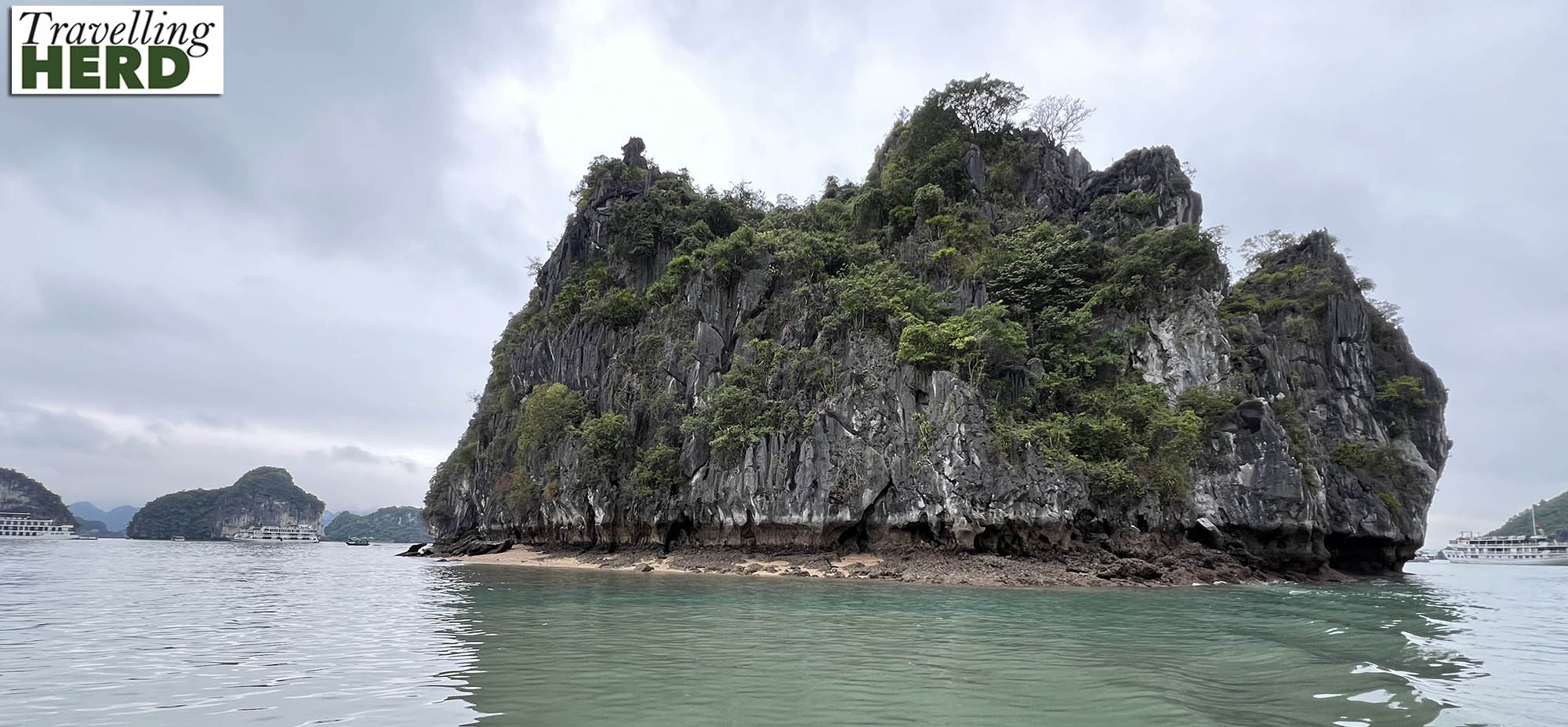
From Ti-Top we cruised on to Sửng Sốt Cave, also called Surprise Cave, on Bo Hon Island and the clouds lifted as we travelled. Fifty steps lead up from the wharf to the entrance to the cave 25 meters above sea level where there is a convenient photo opportunity. . .
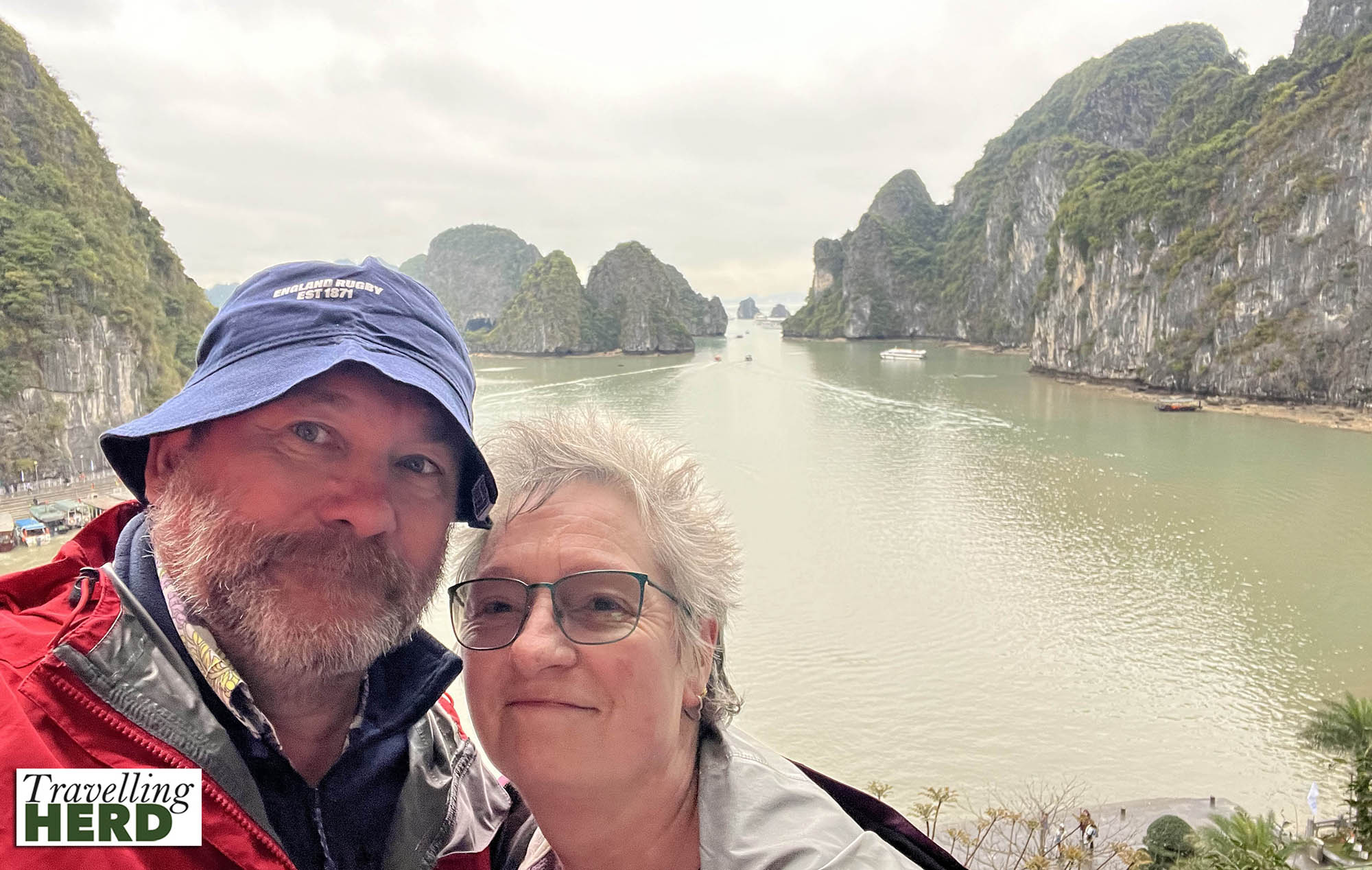
. . . and a view which we felt would rival the one from the top of Ti-Top.
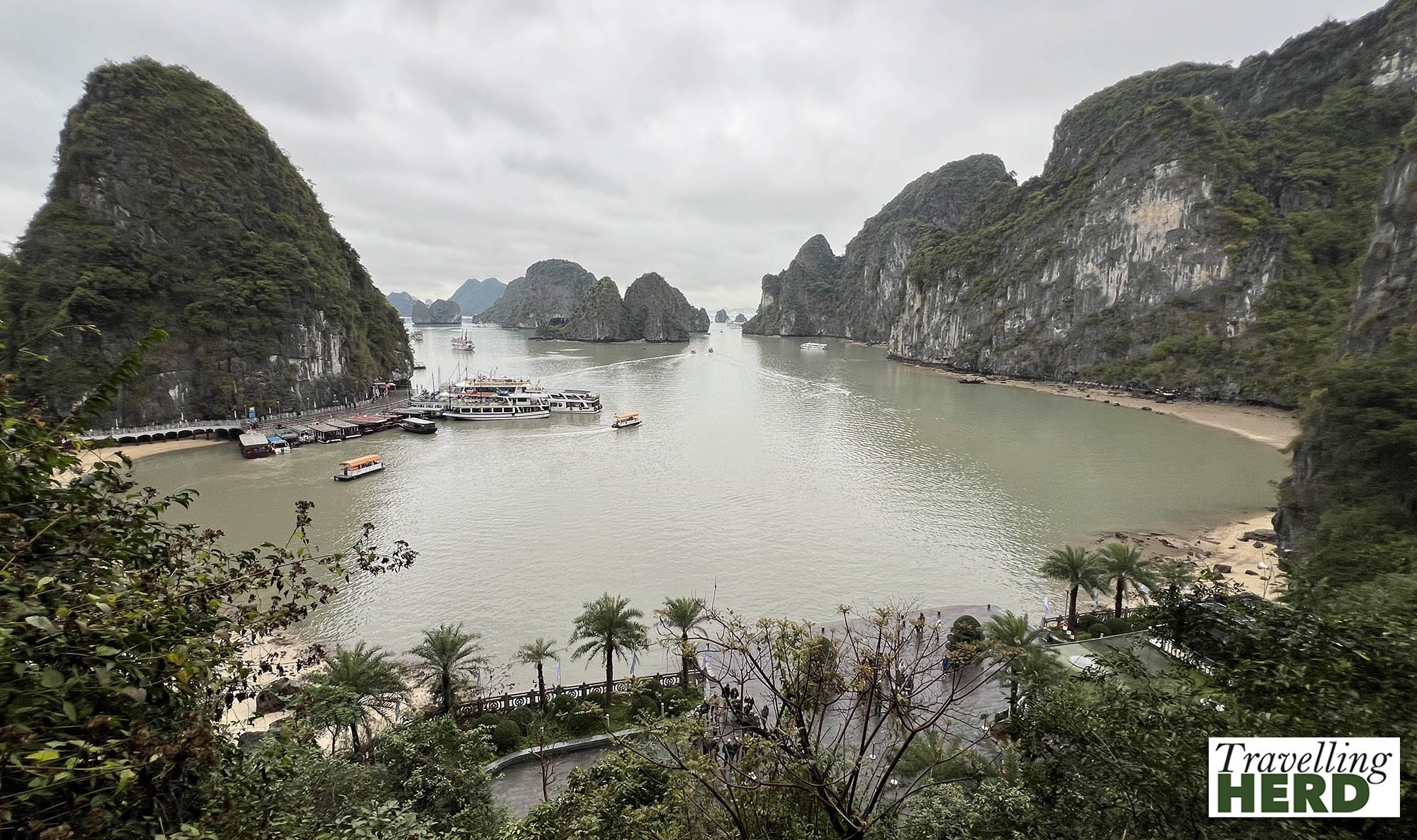
French travellers claimed to discover the cave in 1901, when Vietnam was part of French Indochina but we could not believe that local people had been unaware of its existence before then.
Sửng Sốt Cave is separated into two chambers. The first large chamber is known as the “Waiting Room,” and has many stalactites and stalagmites.
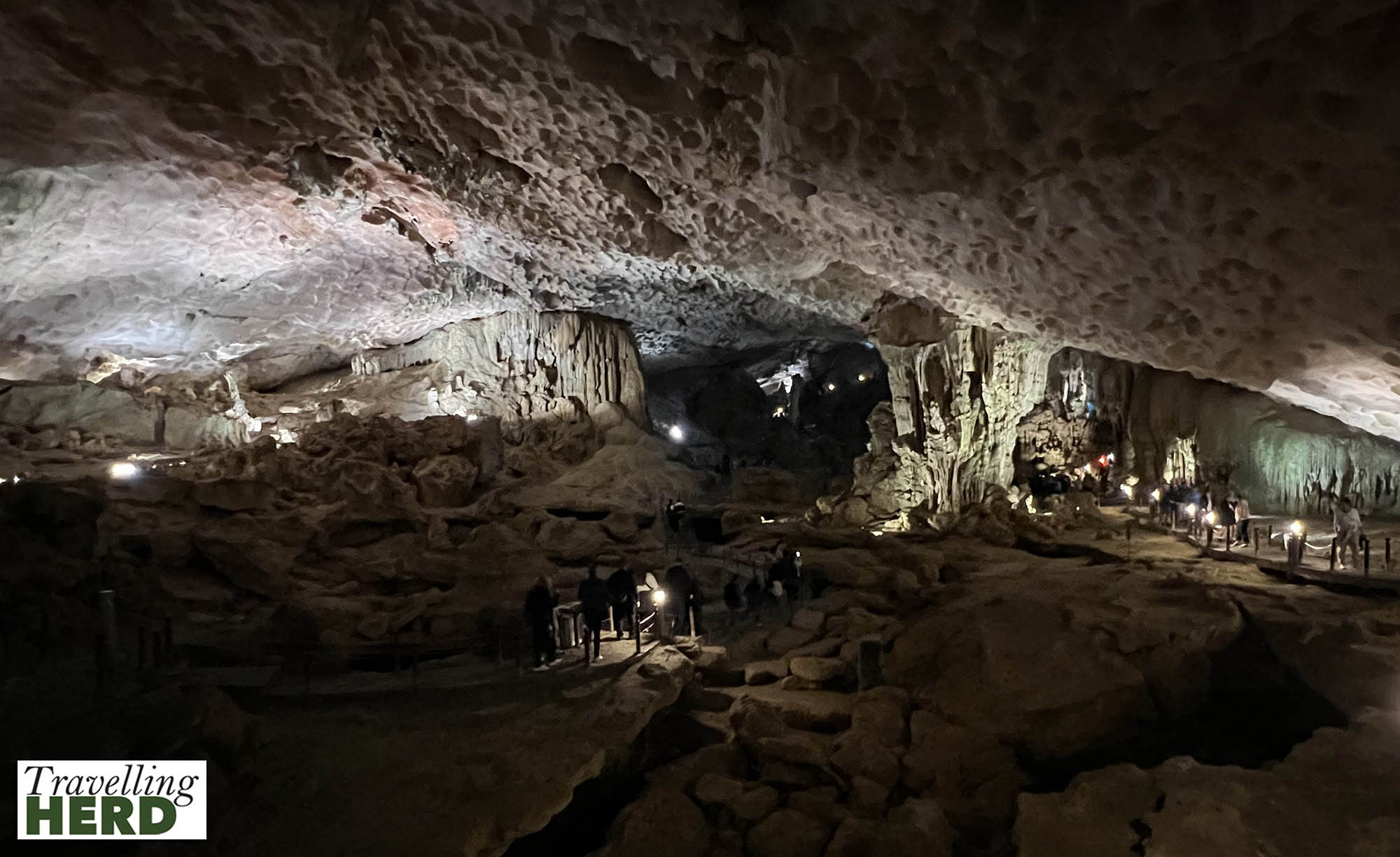
A narrow passageway leads to the second chamber, which is called the “Serene Castle”.
This chamber has high ceilings and numerous intriguing rock formations that locals identify by likening them to animals because of their shapes. The one which resembles either a gun or a pointing finger they have chosen to illuminate with red light. [Robert, however, insists that it resembles something else. But that’s probably just his warped imagination.]
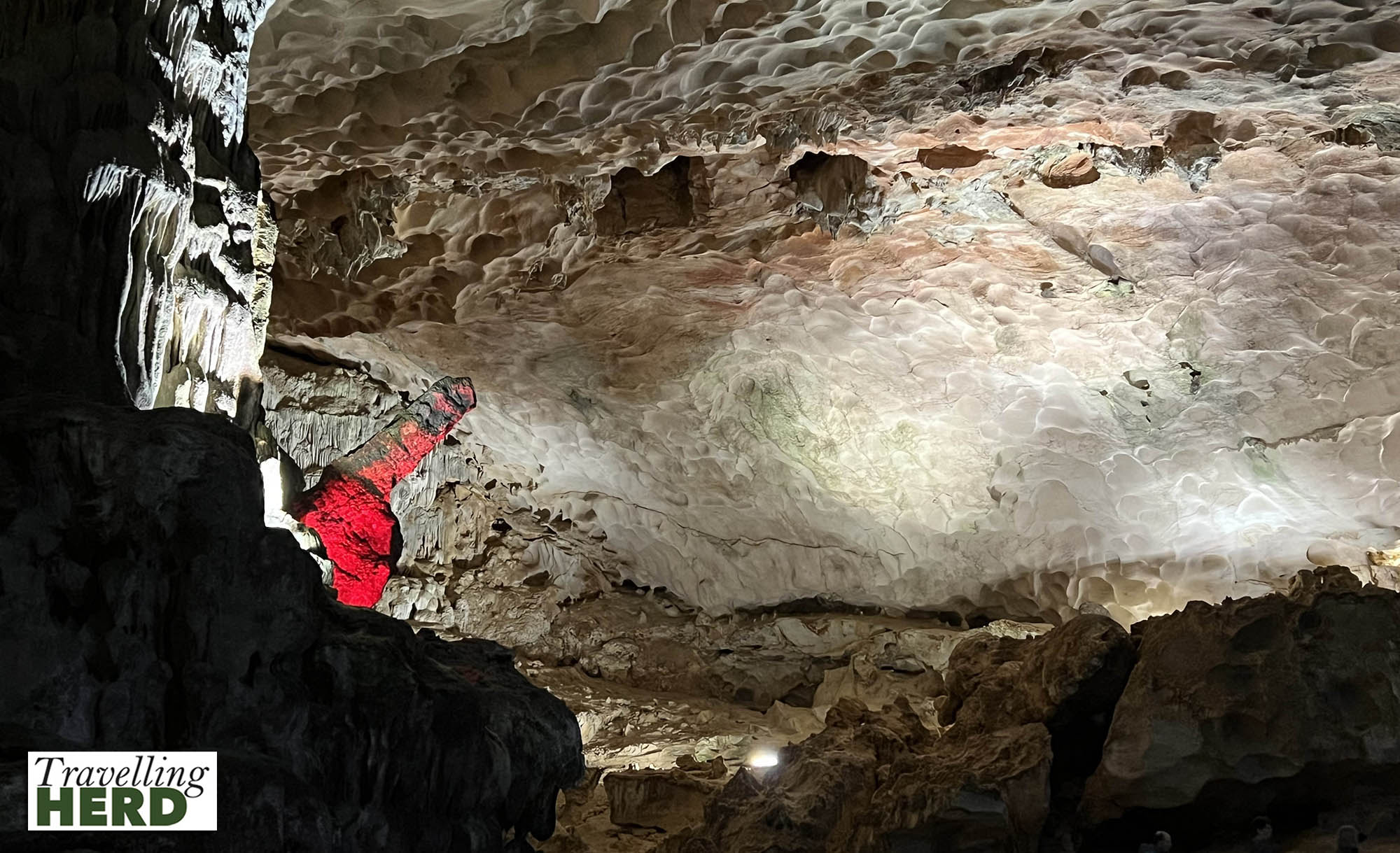
The ceiling almost looks in places as though it has been sprayed with concrete to stabilise it but we were assured that the formations are entirely natural and are formed by water seeping through the rock and the waves eroding the rock.
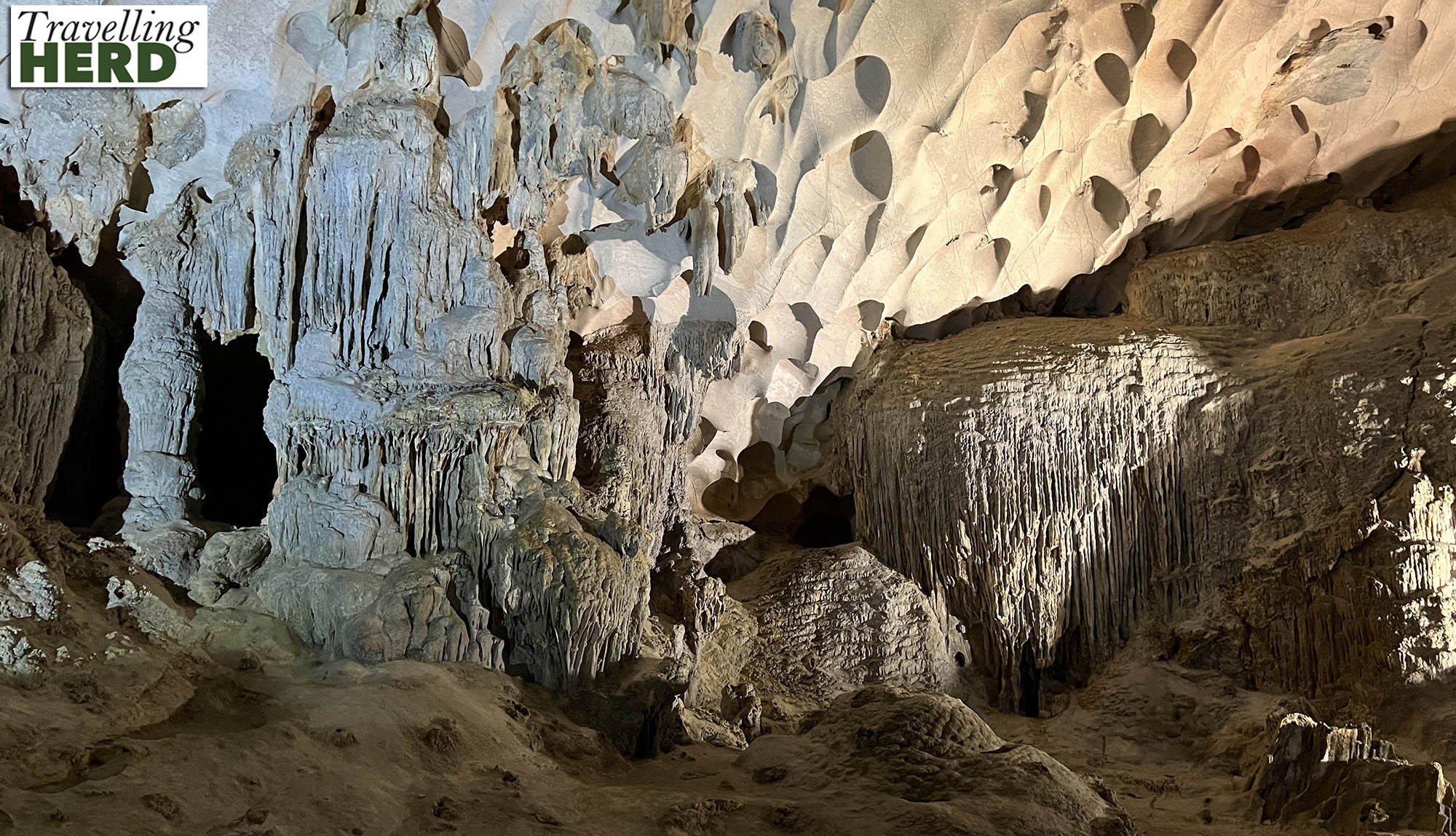
Returning to the Hạ Long Phoenix Cruiser, we shared a meal with our fellow passengers which featured many dishes with a focus on seafood [see Dish of the day] all beautifully presented with vegetables fashioned into flowers and animals.
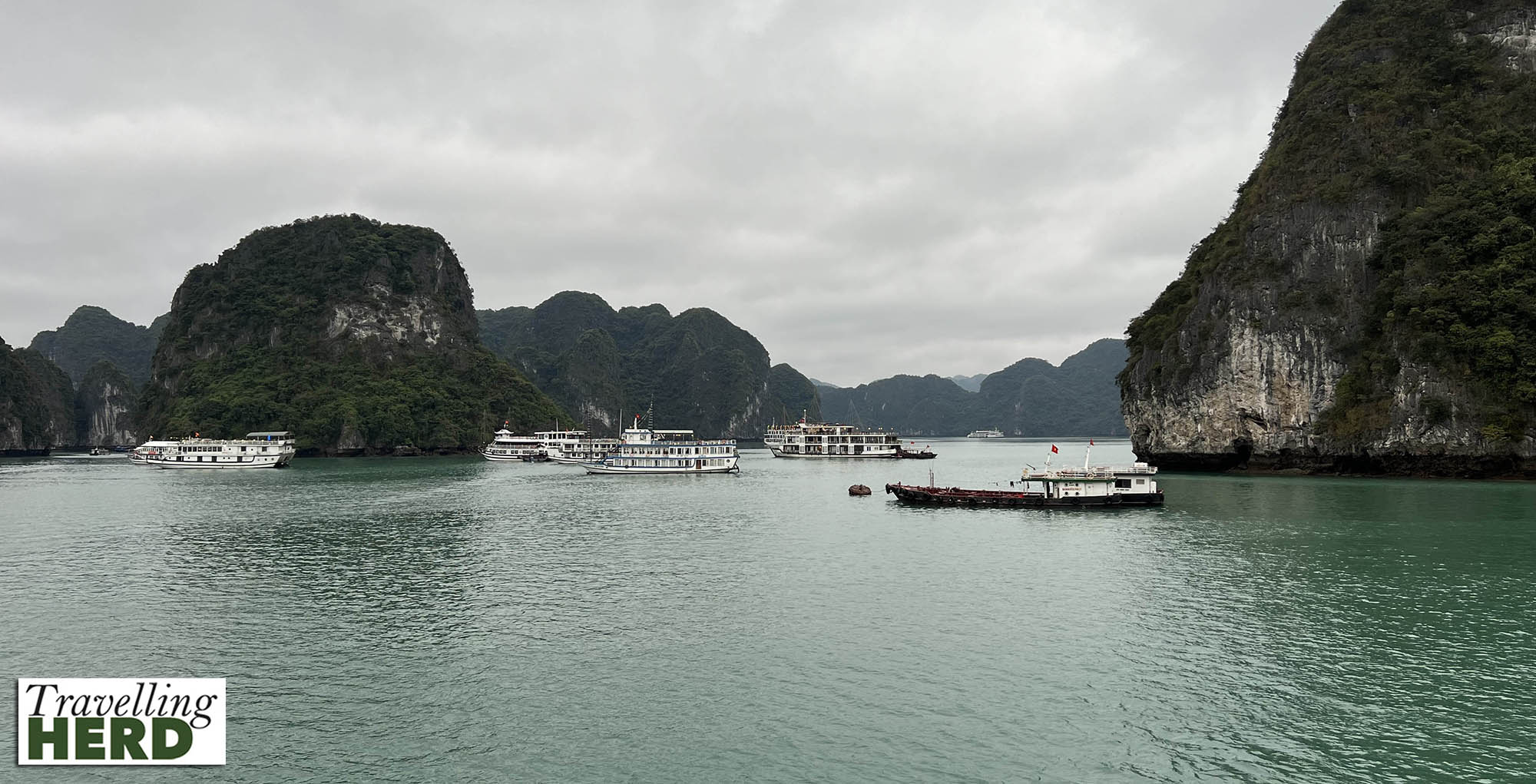
Over five million international visitors come here every year and with the lights on all the cruise ships at night, the bay did seem rather crowded.
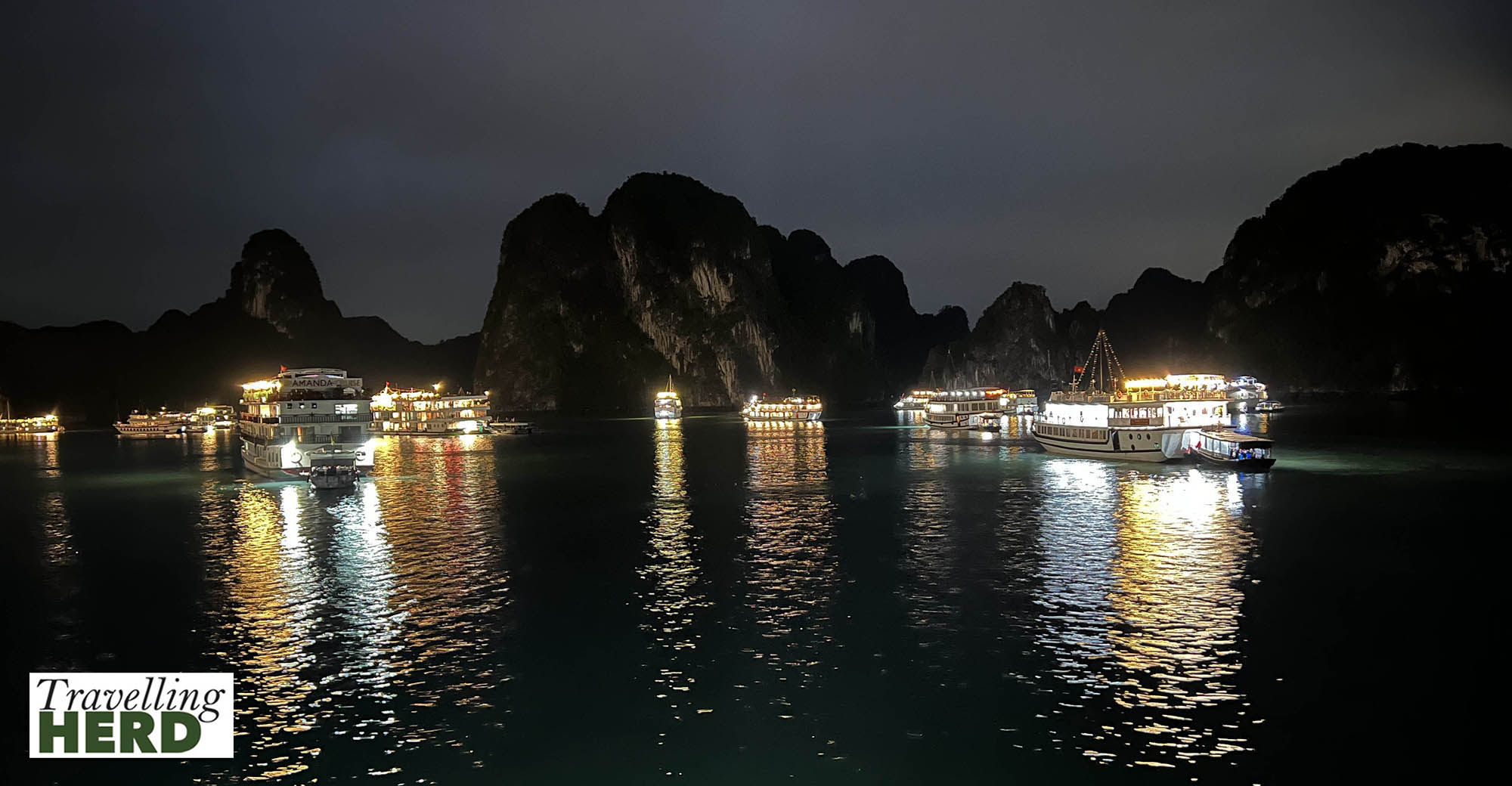
After a rather overcast day, the skies were clearing and our guide suggested we set an alarm to see the sunset. Meanwhile, Robert began to wonder whether he had been mis-sold the trip which was not the peaceful and remote experience he had been expecting.
But all that was about to change.
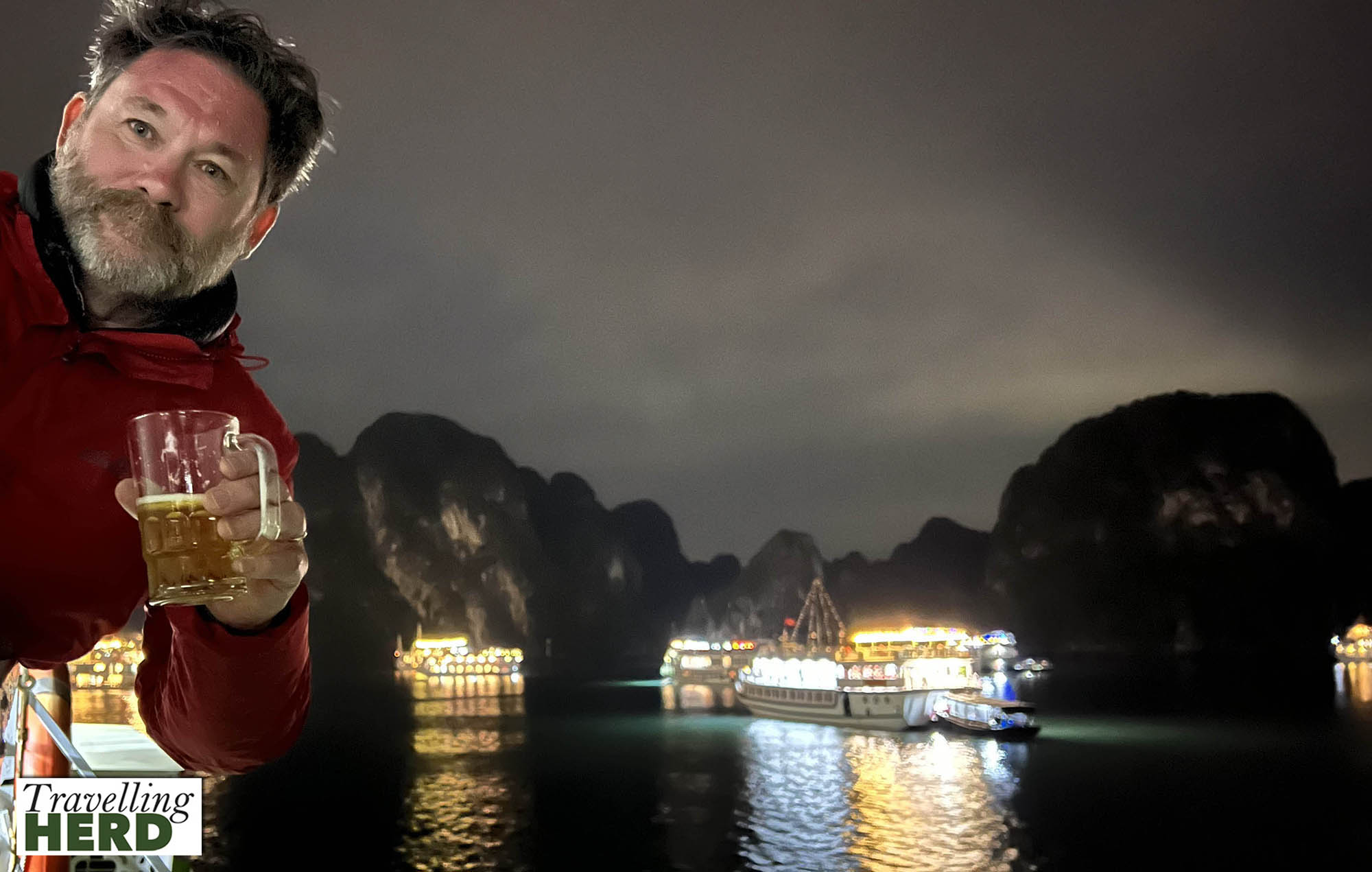
We did not wake the following morning in time to see the sunrise.
Passengers who had booked a one night cruise had to be back at Hạ Long on the mainland by lunch time and so had a very short time for a morning activity. Those, like us, who had booked the two night/three day trip were transported to a smaller day boat where we met our second guide and we set off to see Hạ Long Pearl Farm. Although the tourist cruise boats seem to be everywhere, some of the signs of human activity are carefully concealed behind and amongst the islands.
This was the case with the Hạ Long Pearl Farm owned by the Hạ Long Joint Stock Company where we learned about pearl cultivation.

There are three main types of saltwater pearls: Tahitian, South Sea and Akoya and South Sea pearls are the rarest. The oysters do not need to be fed but they are lifted and cleaned regularly every three months to remove barnacles and other sea life which might affect their health.
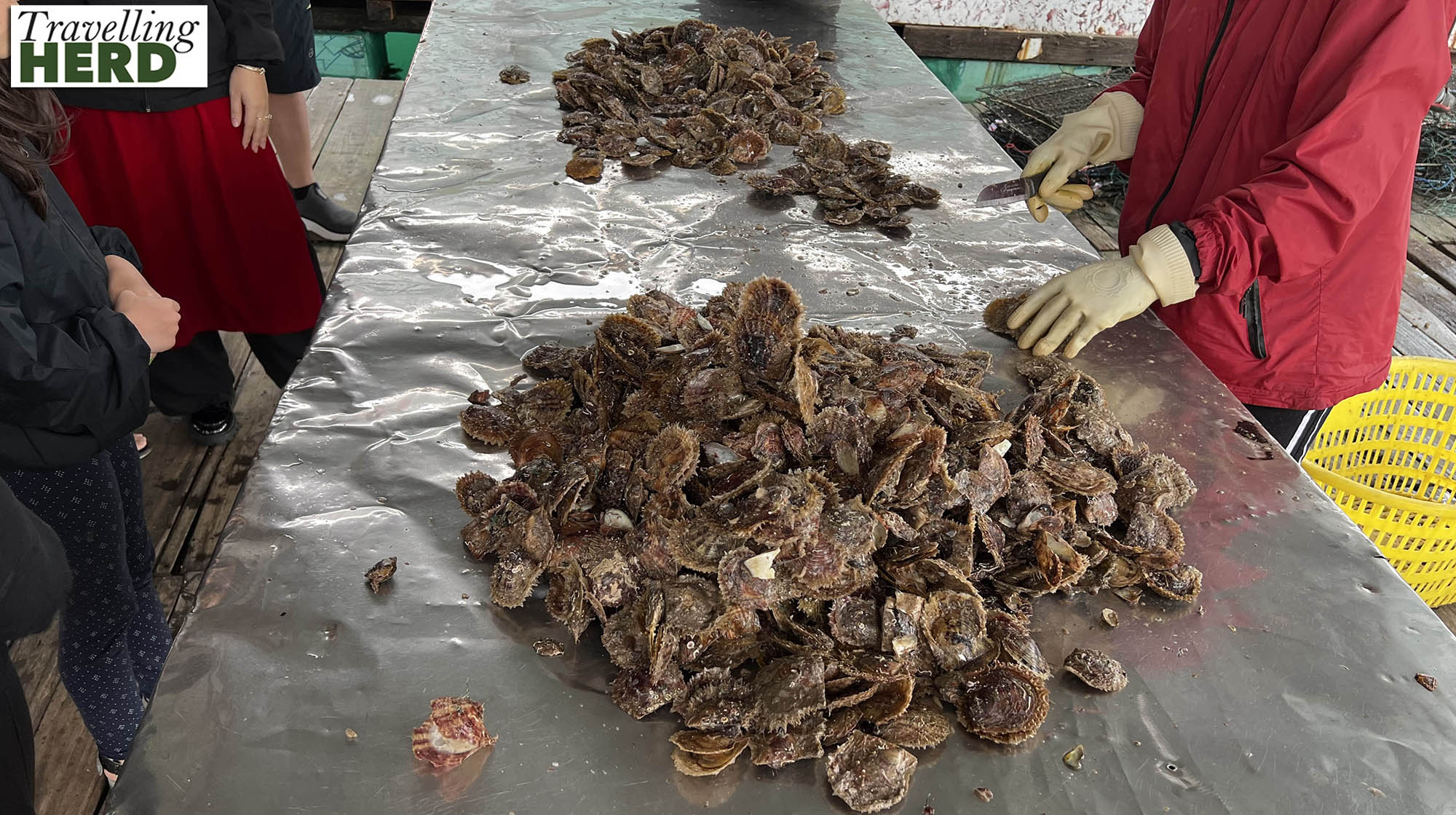
The farm covers 74 acres and consists of roughly 3000 cages with oysters of varying ages.

Fifteen people live at the farm permanently with a further 25 staff employed here but not resident.
Oysters create a pearl in response to the insertion of a ‘pearl nuclei’ which here consisted of a fragment of oyster shell which has been polished into a sphere, together with a fragment of oyster membrane.
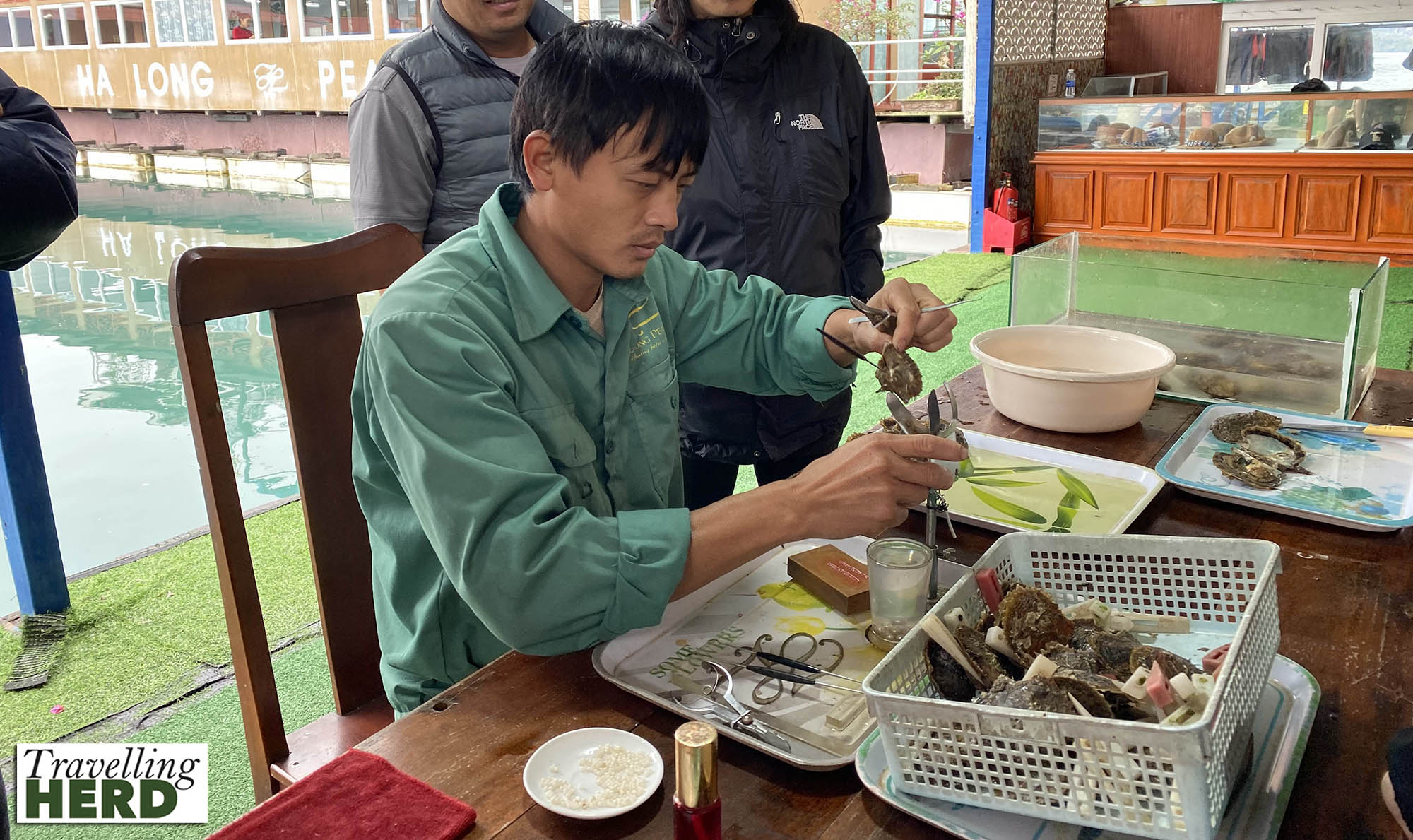
Out of the total number of oysters which are implanted in this way, 50% will die and a further 30% may expel the nucleus and so not produce a pearl at all. There is no quality guarantee and the pearls which are formed may be misshapen or have blemishes: of the 20% which do produce a pearl only 10% will be of the finest quality.
Pearl farmers are patient optimistic people: in optimum conditions it takes five years for a pearl to develop fully.
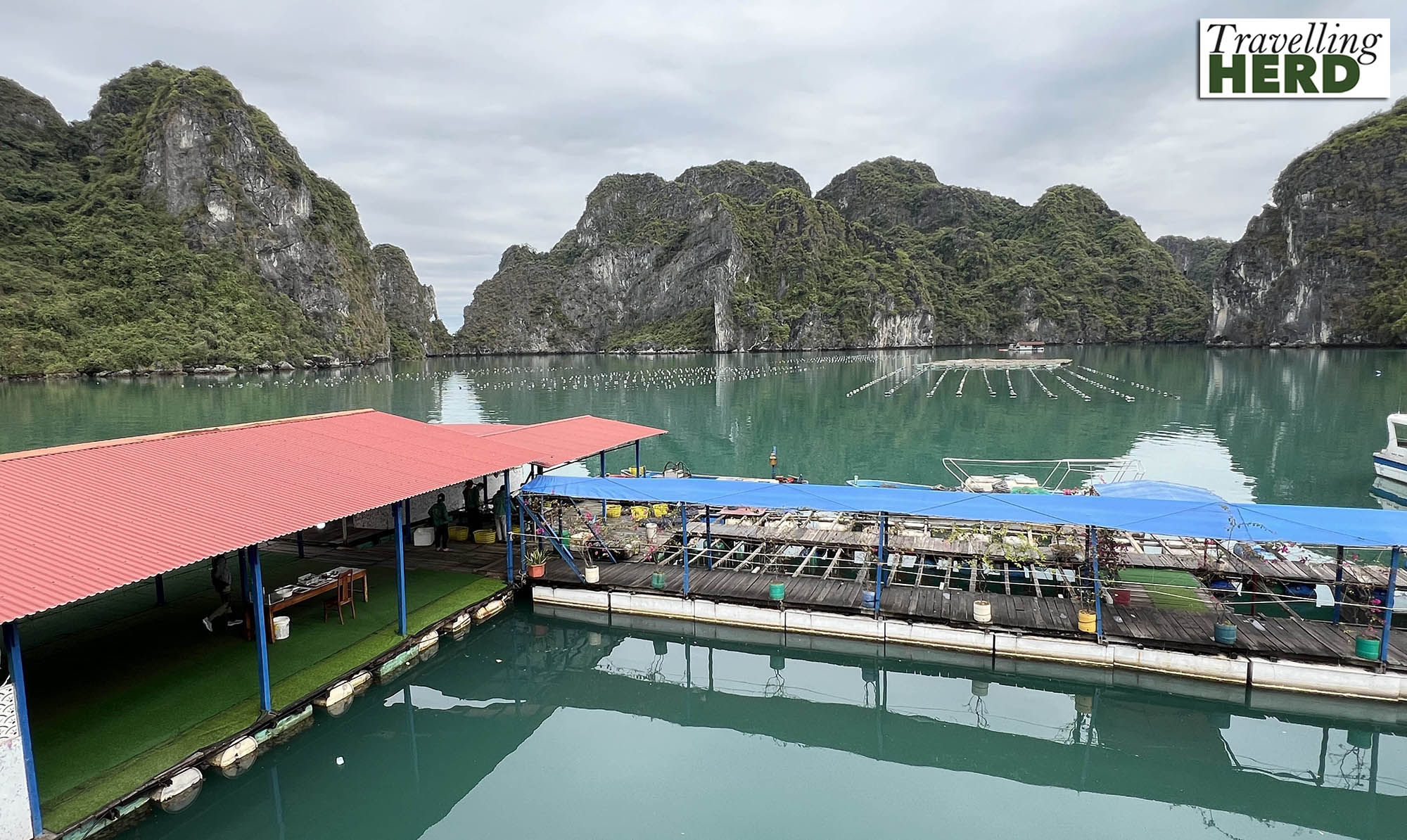
We browsed in the shop – to be honest Matilda browsed with more intent than Robert – but managed to refrain from making any purchases since the most beautiful pearls carried an eye-wateringly expensive price tag.
From the pearl farm, the day boat took us to another site where we had the option to kayak or take what was referred to as a bamboo boat to see some natural caves nearby.
Even though it was enjoyable, Matilda felt that there was a fair amount of misinformation about this next activity. The guide kept stressing the need for a change of clothes and the risk of getting wet so much that we opted for a bamboo boat, which was not, it turned out, made of bamboo.
Our Vietnamese rower clearly enjoyed his job, periodically letting out great whoops. We realised that he was trying to attract the monkeys which live in the trees on the steep slopes of the islands to make an appearance. They were far too distant to photograph but we did see a group of three in the trees, largely visible because of their pale faces and because they were moving and disturbing the foliage.
The caves, it turned out, were not so much caves as open air craters which were reached by passing through a small archway [see Video of the Day]. Those who had opted to kayak returned relatively dry and Matilda felt she might have kayaked through the calm turquoise water in the sunshine if she had not been concerned about becoming lodged in a narrow section of cave. There was no risk of that.
It was undoubtedly spectacularly beautiful though and we agreed that the second day made all the difference: the trip was well worth it.

It is hard to believe, amongst this calm and beauty, that during the Vietnam War many of the channels between the islands were heavily mined by the US Navy. Some of these mines still remain and continue to pose threats to shipping.
Our second guide promised us a sunset party on the top deck.
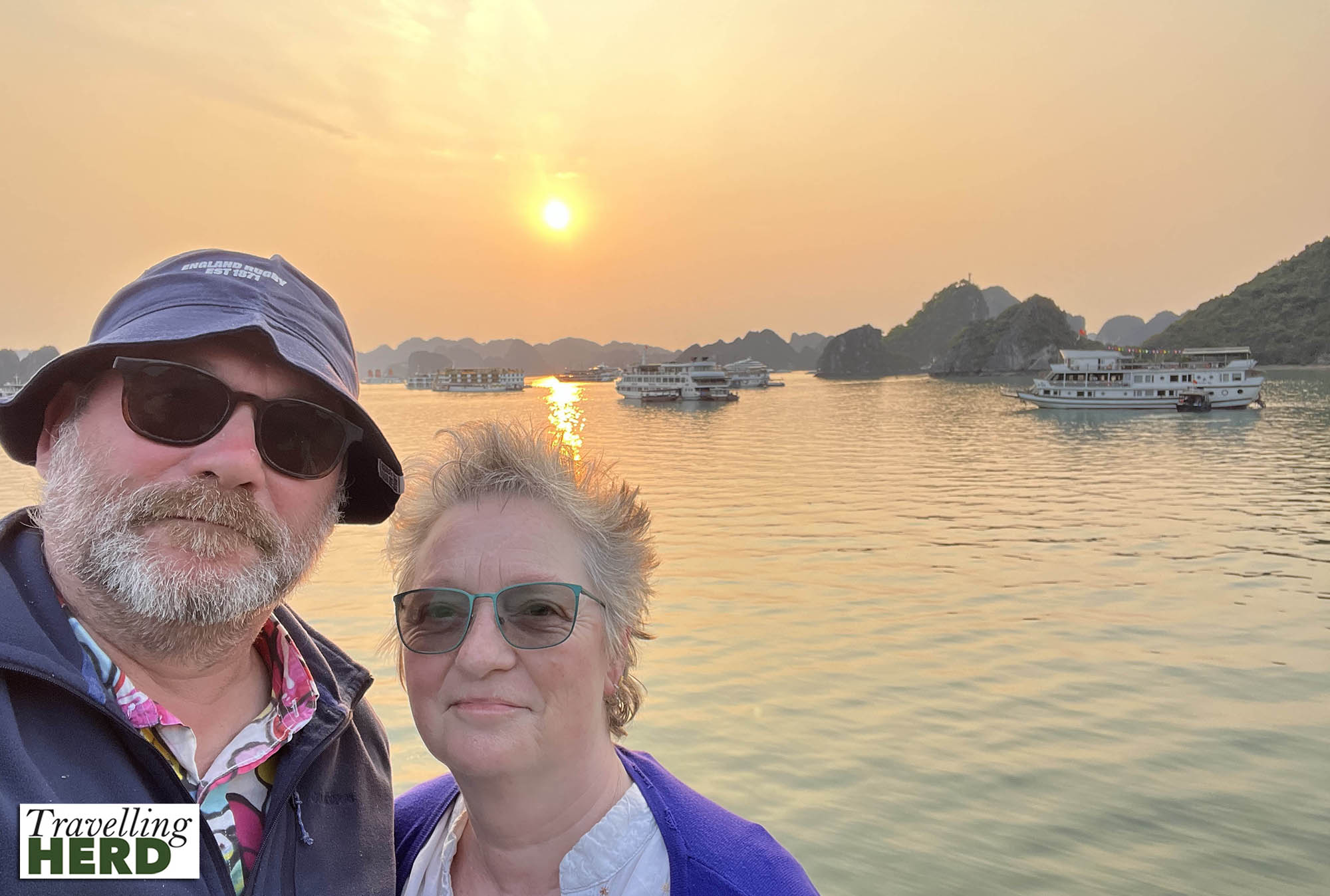
This time the weather did not let us down.

Video of the day:
Selfie of the day:

Dish of the day:
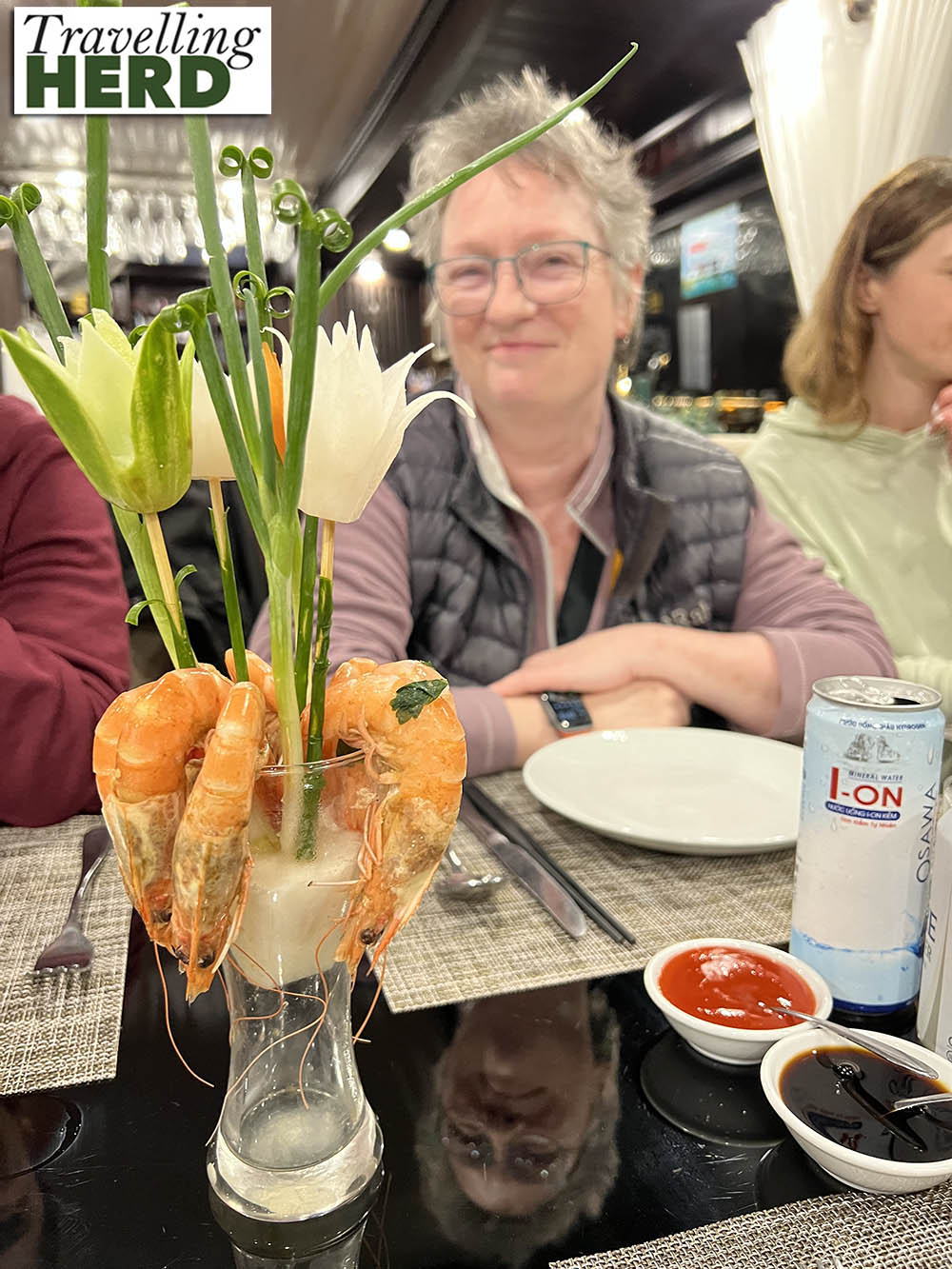
Route Map:
